
Frog 1/72 He-162
| KIT #: | F- |
| PRICE: | $ |
| DECALS: | Two Options |
| REVIEWER: | Carmel J. Attard |
| NOTES: |

| HISTORY |
On Sunday 18th August 2013 during a tour of Vienna and surrounding
areas I made it a point to visit Seegrotte which is a subterranean lake with a
complex system of natural formed tunnels. This is more than the largest
underground lake in Europe as it was the ideal site readily available for the
German Nazi regime to build secret projects away from preying eyes of allied
reconnaissance aircraft that on days on end flew missions to spot on any new
development or activity down below on occupied territories and Germany itself.
Over 2,000 prisoners worked day and night in these tunnels, which were
continuously being pumped from
flooding water to make ample of space for the rapidly developing plans for a new
cheap and effective fighter that the Luftwaffe was so much in need for the
defence of the fatherland against the multitude bombing raids over Germany.
According to the curator there were 200 Heinkels 162s built in these narrow
tunnels. The wings were separate from the fuselage as the narrow tunnels leading
to the 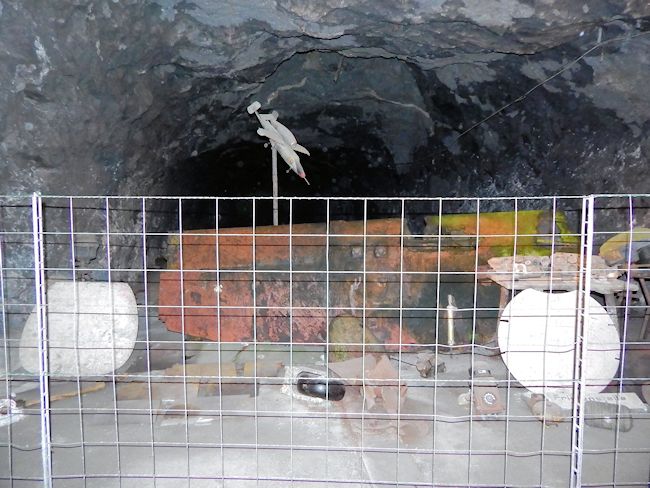 outside
did not allow the aircraft to leave the tunnels in a whole piece and the
assembly line was therefore carried outside the Seegrotte premises. Horses were
the means of transport inside the tunnels. The endless days in dim light gave
rise to partial blindness to these animals so vital to drag the sub assemblies
on carriages inside the tunnels.
outside
did not allow the aircraft to leave the tunnels in a whole piece and the
assembly line was therefore carried outside the Seegrotte premises. Horses were
the means of transport inside the tunnels. The endless days in dim light gave
rise to partial blindness to these animals so vital to drag the sub assemblies
on carriages inside the tunnels.
History
The He 162 Volksjager was a combat aircraft that was conceived, designed, built
and flown, all within the space of 90 days. On September 25th 1945 a
decree of the Fuhrer called for the formation of Germany’s last-ditch equivalent
of the Home Guard under Reichsfuhrer-SS Himmler. Goring saw that the Volksjager
units as the Volksturm’s aerial counterpart. Hurried meetings with General
Keller, then chief of the NSFK (National Socialist Air Corps) the leader of
Hitler’s youth assured him of the manpower necessary to pilot the thousands of
Volksgager which he already envisaged pouring from the production lines.
An entire year’s intake of ‘Hitlerjugend’ was to begin immediately schooling on
gliders before being transferred directly on to Folksgager. German leaders
believed that the transition from glider to jet fighter would require very
little extra practice and the final operational training could be carried out on
active duty.
A basic project requirement had been issued by RLM to major aircraft companies:
Arado, Blohm and Voss, Fiesler, Focke Wolf, Heinkel, Messerschmitt and Junkers.
The project was calling for a simple and inexpensive fighter suitable for
quantity production from readily-available material by semi-skilled and
unskilled labour. The type was to b e powered by a single BMW 003 Sturm turbojet
of no more than 4,409 lbs fully loaded and armed with one or two 30mm cannon,
speeds in excess of 466 mph and in flight endurance of 30 minutes and a take off
run within 1,640 ft. This had to be ready for mass production by 1st
January 1945, a mere 4 months from the issue of the requirement.
A conference was convened at the RLM by which time hurried initial evaluation of
the draft project had been made. Messerschmitt refused to submit any proposal
while the one submitted by Focke Wolf was unrealistic. Arado’s proposal was
reject outright while Heinkel’s offering was considered unsuitable, Blohm and
Voss being judged as best of those submitted. Heinkel was represented by one of
its directors, Francke, who was informed that the proposal was unacceptable on
the grounds that..... a) at sea level it offered flight endurance of only 20
minutes, b) maintenance problems owing to the unusual location of the power
plant, c)did not meet take off requirement, d) it would demand a too long a time
for dismantling for rail transport, e) was intended to carry 20mm calibre weapon
rather than 30mm specified.
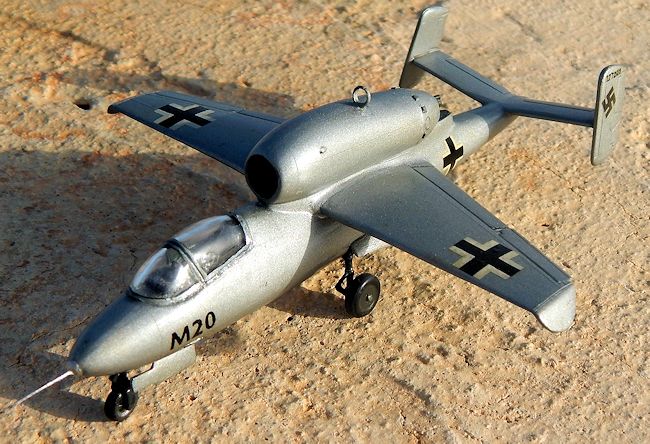 Francke
protested that other submissions had weights and performances calculated by a
different formula than that used by his company. 4 days later a conference was
held and all proposals reviewed where it was again decided that B & V project
P211 was superior in every respect to the other contenders. There was a heated
quarrel between
Heinkel representative and that of B & V. No final decision was made.
Francke
protested that other submissions had weights and performances calculated by a
different formula than that used by his company. 4 days later a conference was
held and all proposals reviewed where it was again decided that B & V project
P211 was superior in every respect to the other contenders. There was a heated
quarrel between
Heinkel representative and that of B & V. No final decision was made.
On 30th September another conference was held and the Chief of
aircraft development announced the selection of Heinkel’s proposal. So Heinkel’s
project, the P1073 was ordered into immediate quantity production with an
initial project output of 1,000 machines per month. Many of the draughtsmen and
engineers working on the project did not leave their office day and night for
several weeks sleeping by their drawing boards. On 29th October
detailed drawings were finally completed and sent to the workshop one day ahead
of schedule.
The He 162 had a light metal monocoque with a molded plywood nose cap. The
single-piece wing was primarily of wood with plywood skinning and detachable
metal tips and attached to the fuselage mainframe by four bolts. Tail-plane,
elevators and rudders were of light metal but fins were wooden construction. The
narrow track undercarriage was retracted hydraulically and spring lowered. A BMW
003 Sturm turbojet attached directly to top of fuselage by 2 vertical bolts at
the forward end and one horizontal bolt at the rear. A single fuselage fuel tank
containing 153 Imp. gallons provided normal fuel supply. An internal wing tank
increased capacity to 168 Imp. gallons. Turbojet itself was started by a Rudel
two-stroke starter motor actuated electrically by switch on the starboard side
of the cockpit. Pilot was provided with a Heinkel designed ejection seat
catapulted from the cockpit in an emergency by means of an explosive charge.
He 162 VI ( work Nr 2000001) flew first time on 6th December. Three
plants were designated Heinkel-North at Marienehe (Rostock) and Junkers at
Bernburg. Both expected eventually to attain monthly output of 1,000 machines
and Mittelwerke at Nordhausen which was expected to deliver 2,000 machines
monthly. The Heinkel-Vienna facility was responsible for all development work
and the construction of the production series of aircraft, and was gradually to
integrate itself to mass production effort using the underground factory
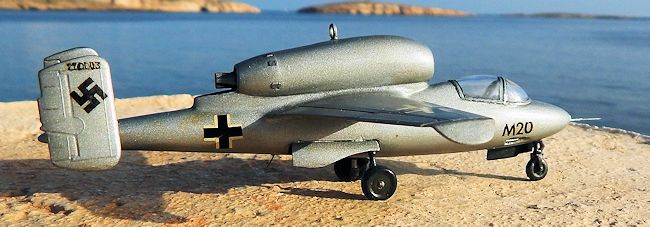 that had
been established in a former chalk mine at Hinterbruhl, near Molding, just
outside Vienna.
that had
been established in a former chalk mine at Hinterbruhl, near Molding, just
outside Vienna.
Although the activities were supposedly cloaked in secrecy, the complete He-162
fuselages were frequently lined up outside the plant as there was insufficient
space in the tunnels to attach the wings. He 162 produced at Hinterbruhl were
220001 while those at Vienna Schwechat –built pre-production machines were
200000 series.
Ground crew training was being undertaken at Neuenmarket and Weideberg near
Bayreuth. The honour of leading the vanguard armada in actual combat was to be
entrusted to Oberst Hubert Ihlefield’s JG1. On the 6th of February
1945 JG1 received orders to hand over its FW190s to II Gruppe and proceed at
once to Parchin for converson to He 162. JG1 spent 9 weeks at Parchin before
transfer to Ludurgslust. 6 days later it made its final move under the command
of Oberleutnant Demuth to its intended base at Lech. Elements from 3 divisions
including Arado 234 jet bombers crowded the runways and surrounding countryside.
Conditions were chaotic, supplies and maintenance facilities hopelessly
inadequate and JG1 was all but immobilised. In the meantime Hitler had taken the
entire programme out of Luftwafe channels and placed in hands of the SS.
In general He 162 pilots avoided combat. Some 120 He 162 were officially
accepted by the Luftwaffe, although 50 more were collected at the factories by
Luftwaffe pilots without official formalities. When hostilities terminated 100
aircraft were awaiting flight testing, while 800 more had reached advanced
stages of assembly at the various plants.
The He 162 was rather unstable around its horizontal axis as a result of the
back-mounted turbojet. An unforgiving machine, demanding the careful handling of
highly-experienced pilots. For 16 year old youths with some cursory gliding
experience to attempt to do so would have been little short of suicidal. On 8th
May 1945 the allied personnel drove through the gates of Lech airfield to take
charge of He 162s intact and lined-up as though for a parade and so ends the
saga of the fantastic Volksjager.
| THE KIT |
Moulded in light grey plastic, containing few part items and including a clear
canopy part, kit is complete with a good decal sheet representing the type that
went into production.
| CONSTRUCTION |
The kit is built to represent He 162V20 (A-2) werk Nr 220003 that was one of the
first few prototype versions operated by Erprobungskommando 162 at Munchen, Reim
flown on February 10th 1945 when it tested a simplified , less expensive
undercarriage.
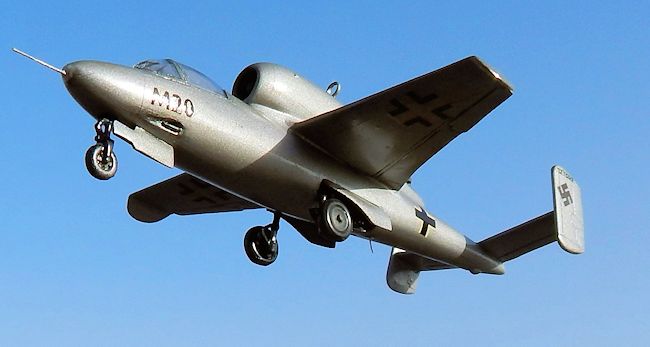 The general
assembly of the kit is problem-free after the initial cleaning up of parts from
the usual joining seams and fins on several of the kit parts not uncommon on old
Frog kits. I opted to build a prototype He 162A but even so to get a resemblance
in accuracy I went through some extra work.
The general
assembly of the kit is problem-free after the initial cleaning up of parts from
the usual joining seams and fins on several of the kit parts not uncommon on old
Frog kits. I opted to build a prototype He 162A but even so to get a resemblance
in accuracy I went through some extra work.
The cockpit office was bare and I have first made a list of what I had in mind to add to the kit which were the following. Ejection seat handle grip and trottle control quadrant on left side of the pilot, control stick, gunsight, instruments on right hand side of pilot seat, cockpit floor and nose wheel well roof, front instrument panel, all from plastic card, crew seat straps. To the exterior the following was also detailed: drilled gun ports and added nose cannons,one on each side made from shaped stretch sprue. A bullet shaped piece at front of air intake rotor of axial flow jet engne, added five tiny inlets to rear of engine mount, partition between undercarriage bays and detail on the inside of each wheel well, hydraulic strut to main undercarriage gear, under fuselage aerial and front fuselage aerial.
| COLORS & MARKINGS |
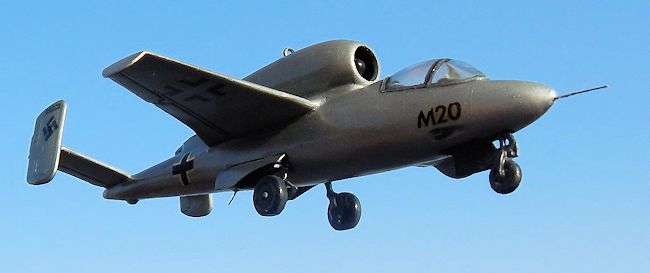 In spite of
age on the model, the kit decals appear to retain original colors even though I
did not go for the kit offer of markings.
In spite of
age on the model, the kit decals appear to retain original colors even though I
did not go for the kit offer of markings.
The prototype aircraft that I choose to build was airbrushed overall silver
dope. Most decals came from spare decal box but the serial number on the tail
fins were hand painted. Interior was dark grey, air intake black and exhaust was
burnt bronze wheel legs in aluminium and all instruments in silver white and
black touches. Two coats of Johnsons Klear sealed the decals and gave the kit a
nice smooth finish.
| CONCLUSIONS |
A ‘must have’ kit for luftwaffe fans representing the final desperate attempts
by the Nazi regime to retard the onslaught brought about by the daily allied
bombing raids. In spite of being a +35 year old kit I am not displeased with the
end result of this model. As I stood there at the entrance to Seegrotte on that
clear August afternoon I simply could picture right in front of my eyes the odd
fuselage pods lying there unattended and abandoned among the beautiful
surrounding greenery at that very
spot ....but this time it was August 2013.............68 years thereafter.
| REFERENCES |
Ref: Flying Review 1967 issue article by William Green.
If you would like your product reviewed fairly and fairly
quickly, please
contact
the editor or see other details in the
Note to
Contributors.